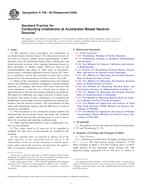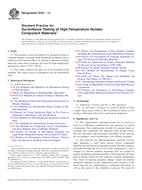Potrebujeme váš súhlas na využitie jednotlivých dát, aby sa vám okrem iného mohli ukazovať informácie týkajúce sa vašich záujmov. Súhlas udelíte kliknutím na tlačidlo „OK“.
ASTM E798-96(2009)
Standard Practice for Conducting Irradiations at Accelerator-Based Neutron Sources
Automaticky preložený názov:
Štandardné praktiky pre dirigovanie ožiarenia pri Accelerator-Based neutrónových zdrojov
NORMA vydaná dňa 1.8.2009
Informácie o norme:
Označenie normy: ASTM E798-96(2009)
Poznámka: NEPLATNÁ
Dátum vydania normy: 1.8.2009
Kód tovaru: NS-48025
Počet strán: 13
Približná hmotnosť: 39 g (0.09 libier)
Krajina: Americká technická norma
Kategória: Technické normy ASTM
Kategórie - podobné normy:
Anotácia textu normy ASTM E798-96(2009) :
Keywords:
accelerators, cyclotrons, fusion, ion irradiation, radiation damage simulation, spallation, Deuterium-tritium interactions, Fast neutron flux/fluence, Irradiance/irradiation, Lithium/beryllium targets, Neutron activation reactions, Neutron flux/fluence, Neutron radiation--nuclear materials/applications, Radioactivation--fast neutron flux, Threshold detectors--14 MeV, Accelerators, Beryllium-lithium targets, Cyclotrons, ICS Number Code 27.120.10 (Reactor engineering)
Doplňujúce informácie
| 1. Scope | ||||||||||||||||||||||
|
1.1 This practice covers procedures for irradiations at accelerator-based neutron sources. The discussion focuses on two types of sources, namely nearly monoenergetic 14-MeV neutrons from the deuterium-tritium T(d,n) interaction, and broad spectrum neutrons from stopping deuterium beams in thick beryllium or lithium targets. However, most of the recommendations also apply to other types of accelerator-based sources, including spallation neutron sources (1). Interest in spallation sources has increased recently due to their proposed use for transmutation of fission reactor waste (2). 1.2 Many of the experiments conducted using such neutron sources are intended to simulate irradiation in another neutron spectrum, for example, that from a DT fusion reaction. The word simulation is used here in a broad sense to imply an approximation of the relevant neutron irradiation environment. The degree of conformity can range from poor to nearly exact. In general, the intent of these simulations is to establish the fundamental relationships between irradiation or material parameters and the material response. The extrapolation of data from such experiments requires that the differences in neutron spectra be considered. 1.3 The procedures to be considered include methods for characterizing the accelerator beam and target, the irradiated sample, and the neutron flux and spectrum, as well as procedures for recording and reporting irradiation data. 1.4 Other experimental problems, such as temperature control, are not included. 1.5 The values stated in SI units are to be regarded as standard. No other units of measurement are included in this standard. 1.6 This standard does not purport to address all of the safety concerns, if any, associated with its use. It is the responsibility of the user of this standard to establish appropriate safety and health practices and determine the applicability of regulatory limitations prior to use. |
||||||||||||||||||||||
| 2. Referenced Documents | ||||||||||||||||||||||
|
Podobné normy:
Historická
1.2.2014
Historická
1.1.2014
Historická
1.8.2009
Historická
1.1.2013
Historická
1.1.2014
Historická
15.7.2007
Odporúčame:
Aktualizácia technických noriem
Chcete mať istotu, že používate len platné technické normy?
Ponúkame Vám riešenie, ktoré Vám zaistí mesačný prehľad o aktuálnosti noriem, ktoré používate.
Chcete vedieť viac informácií ? Pozrite sa na túto stránku.



 ASTM E2956-14
ASTM E2956-14 ASTM E509/E509M-14..
ASTM E509/E509M-14.. ASTM E521-96(2009)e1..
ASTM E521-96(2009)e1.. ASTM E531-13
ASTM E531-13 ASTM E636-14
ASTM E636-14 ASTM E900-02(2007)..
ASTM E900-02(2007)..
 Cookies
Cookies
